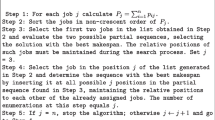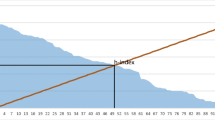Abstract
This paper reports on a quantitative analytical methodology which deals with perceptions of scientific experts regarding the intellectual shape and contents (‘cognitive structure’) of their scientific domain. This study examines the method's utility for studying expert views in general, and, more specifically, its strengths and weaknesses as a tool for improving validation studies of bibliometric maps involving subject experts. The main premise is that expert views are based on their internal knowledge structures (‘mental schemes’) of which relevant features can be captured in quantitative data. This approach allows a rigorous and systematic way of studying mental schemes across subject experts. Spatial representations of their data (‘mental maps’) provide insight in properties underlying those knowledge structures. Data from different experts are reconciled to construct a ‘common’ mental map which displays a group view. This study includes a test to establish the validity of individual mental maps and common mental maps. The methodology is applied to the views of 14 researchers in the field of neural network research and related areas. Key-findings are: (i) mental maps can provide valid representations of expert mental schemes, (ii) experts sharing the same subject field are more likely to share views, (iii) expert judgements of bibliometric maps are affected by the structure of their own mental schemes, as well as (iv) by their views regarding the utility of those maps, and (v) common mental maps and a bibliometric co-word map based on the same set of items differ significantly, showing a resemblance on main features only.
Similar content being viewed by others
Notes and references
R. J. W. Tussen,Cartography of Science: Scientometric Mapping with Multidimensional Scaling Methods, Leiden, DSWO Press, 1992.
A. Rip, Mapping of science: possibilities and limitations, In:A. F. J. van Raan (Ed.),Handbook of Quantitative Studies of Science, Amsterdam, Elsevier Science Publishers, 1988.
N. J. Belkin, The cognitive viewpoint in information science,Journal of Information Science, 16 (1990) 11–15.
B. C. Brookes, The foundations of information science. Part III. Quantitative aspects: objective maps and subjective landscapes,Journal of Information Science, 2 (1980) 269–275.
B. C. Brookes, The foundations of information science. Part IV. Information science: the changing paradigm,Journal of Information Science, 3 (1981) 3–12.
K. R. Popper, Objective Knowledge:An Evolutionary Approach, Oxford, Clarendon Press, 1972.
M. De Mey, The cognitive viewpoint: its development and its scope,Communication and Cognition, 10 (1977) 7–23.
E. Garfield, M. V. Malin, H. Small, Citation data as science indicators, In:Elkana, Y., J. Lederberg, R. K. Merton, A. Tackeray, A. H. Zuckerman (Eds),Toward a Metric of Science, Chichester, Wiley, 1978.
P. Healey, H. Rothman, P. Hoch, An experiment in science mapping for research planning,Research Policy, 15 (1986) 233–251.
K. W. McCain, Cocited author mapping as a valid representation of intellectual structure,Journal of the American Society for Information Science, 37 (1986) 111–122.
J. Dumont, Validity of multidimensional scaling in the context of structured conceptualization,Evaluation and Programme Planning, 12 (1989) 81–86.
R. J. W. Tussen, A quantitative assessment of interdisciplinary structures in science and technology: Co-classification analysis of energy research,Research Policy, 21 (1992) 27–45.
H. Peters, A. F. J. van Raan, Co-word based maps of chemical engineering: I-representations by direct multidimensional scaling,Research Policy, 22 (1993) 23–45.
A. J. Nederhof, R. J. W. Tussen, E. C. M. Noyons, Comparison of journal-journal citation maps of linguistics and experimental psychology with maps based on expert knowledge: a validation study. Submitted toJournal of the American Society for Information Science.
R. J. W. Tussen, Mapping the cognitive structure of scientific fields: A comparison of experts' opinions and bibliometric data, In:Van Raan, A. F. J. et al. (Eds),Science and Technology in a Policy Context, Leiden, DSWO Press, 1992.
See e. g.,U. Neisser,Cognitive Psychology, New York, Appleton-Century-Crofts, 1976.
See e. g.,D. E. Rummelhart, Schemata and the cognitive system, In:Wyer, R., T. Srull (Eds),Handbook of Social Cognition, Vol. 1, Hillsdale, NJ, Erlbaum, 1984.
See e. g.,A. D. Gordon, P. E. Jupp, R. W. Byre, The construction and assessment of mental maps,British Journal of Mathematical and Statistical Psychology, 42 (1989) 169–182.
B. Barnes, The conventional component in knowledge and cognition, In:N. Stehr, V. Meja (Eds),Society and Knowledge: Contemporary Perspectives in the Sociology of Science, New Brunswick, Transaction Books, 1984.
J. D. Carroll, J. J. Chang, Analysis of individual differences in multidimensional scaling via an N-way generalization of Eckart-Young decomposition,Psychometrika, 35 (1970) 283–319.
A. F. J. van Raan, R. J. W. Tussen, The neural net of neural network research: An exercise in bibliometric mapping,Scientometrics, 26 (1993) 169–192.
This supports results of earlier work byF. Bastide, J. P. Courtial, M. Callon, The use of review articles in the analysis of a research area,Scientometrics, 15 (1989) 535–562, which indicate that review articles appear to be useful and valid as a second bibliometric mode of analysis for describing cognitive structures and their dynamics.
Op. cit. 20..
Author information
Authors and Affiliations
Rights and permissions
About this article
Cite this article
Tijssen, R.J.W. A scientometric cognitive study of neural network research: Expert mental maps versus bibliometric maps. Scientometrics 28, 111–136 (1993). https://doi.org/10.1007/BF02016288
Received:
Issue Date:
DOI: https://doi.org/10.1007/BF02016288




